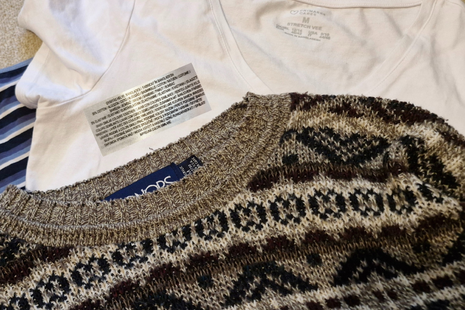Why material matters
Annia Krzoska explains why we should pay more attention to what our clothes are made from when suiting our styles to the season

When the season changes, we often reach for more layers that we can don and shed as necessary. While layering is a great way to adjust your outfit to the whims of the weather, it’s no secret that lugging a jumper around all day can be frustrating – and sometimes it doesn’t keep you warm. Likewise, sometimes even a t-shirt can feel suffocatingly hot. The answer to suiting your style to the season is not in how much clothing you wear, but focusing on what materials make up the base of your outfit.
In the summer, steer clear of polyester where you can. As a synthetic fabric, polyester does not absorb moisture from the skin. When you sweat, it stays trapped beneath your t-shirt. This makes you feel warmer. The UK’s humidity is bad enough without your clothes adding to the problem. Saving a couple of quid isn’t worth the pain; invest in cotton clothing where you can. Many high street stores have cottoned on to the pitfalls of polyester, and you can find cheap, breathable ‘cotton blends’ in places like Primark for just a little bit more than the polyester alternative – this way, you can stay cool even if your clothes are largely covering your skin.
“Many high street stores have cottoned on to the pitfalls of polyester, and you can find cheap, breathable ‘cotton blends’ in places like Primark”
However, opting for polyester in the winter can be a smart move. Thermals are often made from fabric blends, mixing polyester, fleece, merino wool and other similar fabrics. The UK winter is not typically cold enough to make thermals an everyday staple, but those few who like to torture themselves with early morning rowing outings should consider investing in a pair of leggings made with the materials listed above.
Fleece as a material is also incredibly effective at keeping you warm. As such, you might wish to avoid it in the Autumn when the rain outweighs the cold. A light wool (or synthetic alternative) jumper should do the trick - especially if the fabric is thin enough that you can comfortably roll the sleeves up. These are super easy to buy second-hand, and wool is a lot more durable than its synthetic alternatives! During rainy seasons, stick to lightweight clothes where possible. There’s nothing worse than spending your day weighed down by a soaking-wet hoodie that has no opportunity to dry. If you haven’t fallen into the River Cam, there’s no need to look like you have. It’s not a trendy look.
With accessories like scarves, you should think about your intention. Are you wearing the scarf because you’re cold, or because it looks good with your outfit? The way the material is woven is what matters most here. You could have a wool scarf that is completely impractical if it is knitted loosely, just like a cotton or silk scarf in the winter. Think about how the material works and make your outfit choices based on that. You wouldn’t wear a loosely knitted ‘summer’ jumper in a snowstorm.
“The way the material is woven is what matters most here”
Material also matters when it comes to footwear. Wearing canvas trainers is the worst possible choice when it’s raining - speaking from experience. Leather would be a better choice, though you need to be careful not to ruin your shoes. Nylon or synthetic rubber (the material used to make most trainers) is probably your best bet. You may wish to avoid leather in the summer - especially leather boots. These trap heat. Opt for something breathable like canvas instead.
Even jewellery has some material considerations. You may have heard that fake silver can turn your skin green; it can. Look for a ‘925’ marking inside of any rings you wish to purchase before going for it. Silver is not necessarily expensive (I have seen rings made from various alloys at the same price as their silver alternative in the same shop), but your jewellery will last longer and you won’t have to worry about green skin. With earrings, you need to make sure the material is light enough not to hurt your ears. Plastic, clay, etc are all good picks - metal is less so (if it’s dangling and not a stud). Even if jewellery doesn’t affect how hot or cold you are, it does affect your comfort - and you want to be comfortable, especially when battling the changing weather.
 News / Cambridge academics stand out in King’s 2026 Honours List2 January 2026
News / Cambridge academics stand out in King’s 2026 Honours List2 January 2026 Interviews / You don’t need to peak at Cambridge, says Robin Harding31 December 2025
Interviews / You don’t need to peak at Cambridge, says Robin Harding31 December 2025 Comment / What happened to men at Cambridge?31 December 2025
Comment / What happened to men at Cambridge?31 December 2025 News / Varsity’s biggest stories of 202531 December 2025
News / Varsity’s biggest stories of 202531 December 2025 Features / “It’s a momentary expression of rage”: reforming democracy from Cambridge4 January 2026
Features / “It’s a momentary expression of rage”: reforming democracy from Cambridge4 January 2026










